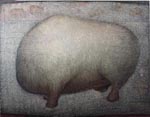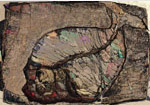Sergeyev Sergey. Bull’s Whisper (painting, graphics).
 Booklet. Curator – Andrey Khlobistin. The oeuvre of Sergeyev Sergey embraces the cutting edge of modern art. Masterly creating the effects of different (including fantastic) materials, textures and even sounds, his works hover on the whimsical verge of conservatism and experimentation, traditionalism and exoticism, expressive materiality and ephemerality. They can be said to flicker vaguely in texture and meaning, without ever fully revealing themselves. The viewer is intrigued by their rich pageantry, which can, at a moment’s notice, turn into melancholy chilliness and distance. This effect is created by the very texture of Sergeyev’s works, harbouring the spiritual and subject content and creating the space of co-existence. Even when the artist employs the resources of painting to create the illusion of the surface of metal or stone, his works are still living organisms, changing during their contemplation and living alongside them.
Booklet. Curator – Andrey Khlobistin. The oeuvre of Sergeyev Sergey embraces the cutting edge of modern art. Masterly creating the effects of different (including fantastic) materials, textures and even sounds, his works hover on the whimsical verge of conservatism and experimentation, traditionalism and exoticism, expressive materiality and ephemerality. They can be said to flicker vaguely in texture and meaning, without ever fully revealing themselves. The viewer is intrigued by their rich pageantry, which can, at a moment’s notice, turn into melancholy chilliness and distance. This effect is created by the very texture of Sergeyev’s works, harbouring the spiritual and subject content and creating the space of co-existence. Even when the artist employs the resources of painting to create the illusion of the surface of metal or stone, his works are still living organisms, changing during their contemplation and living alongside them.  During the great «geological» breakdown of world art in the early twentieth century, the classical Russian avant-garde assigned primary importance to texture, defining the subsequent development of art. * Continuing the spiritual-mystical tradition of Old Russian art, Kazimir Malevich, Mikhail Matiushin, Nikolai Punin and Voldem257;rs Matvejs symbolised and semantised the texture of the work. Aiming to express the absolute, they subordinated everything to the cult of pure texture, leading to the disappearance of colour and paint, to minimalist abstractions and, as a result, to zero — a virtually empty canvas. At the turn of the millennium, unable to resolve the problems of modernism, art is once again facing a crisis so profound that it is difficult to even problematically define its substance. In this situation, creativity exists as the intention, hope and desire of art, engaged in searches on the intermittent border of sensations, intonations and textures. The frontline of quests lies in this sphere, independent of whether the artist works in Photoshop, filigree retouching or experiments with his own corporeality. Sergeyev Sergei has worked in this sphere for many years. Sergeyev first sprung to prominence on the local art scene in the late 1970s, after studying at the Valentin Serov and Vera Mukhina Schools of Art. Forming the Alipius group with a number of friends, he joined the nonconformist movement, simultaneously studying the works of the Old Masters and the great Flemish artists in particular. In the early 1980s, he was a member of the Fellowship of Experimental Fine Art and worked in the New Wave style. A friend of Timur Novikov, he exhibited alongside his New Artists group. Sergeyev’s main genres at this time were the still-life, landscape and portraiture. Timur Novikov discerned an individuality based on the aspiration towards perfection of content and form. In the early 1990s, Sergeyev returned to tempera painting, creating a major cycle of works dedicated to St Petersburg. The artist’s trademark texture – simultaneously historical and living – can be seen in the details of his landscapes and still-lifes from this period. In his subsequent works, the artist grew closer and closer to the surfaces of the fragments of his works. These semi-abstract surfaces occupied the entire space of the picture, incorporating an endless depth. In the mid-1990s, influenced by studies of anthropology, physiology and psychiatry and Crimean psychiatrist Victor Samokhvalov in particular, Sergeyev Sergey formulated the main subject of his oeuvre – «palimpsest» ** This term perfectly reflects the work of an artist who combines the traditions of mastery with incessant quests. His works become increasingly “sculptural”, sometimes creating the effect of a trompe-l’oeil, *** evoking the desire to touch the surface of the picture. Sergeyev’s «made» and virtuoso works have reached the mystical limits of the overflowing of the texture of the stone, metal and bone, craquelure crossing over into fretwork and letters, and cracks turning into symbols. The effect of breathing, whispering and murmuring creates an aura, passing beyond the physical bounds of the works. Multi-layered, multi-textural, multi-ciphered and silently multi-vocal, all this might be regarded as a sign of the «schizophrenisation» of a work of modern art, only this would be a mistake with respect to Sergeyev Sergey. His works are not friable; they are organic, confirming unity in multiple meanings. Like obelisks, they are internally monumental and externally statuary. They betray the profundity of the inmost national tradition, which does not divide the material from the spiritual, the living from the dead and the past from the future. Andrey KHLOBYSTIN * For an outstanding piece of research see Ekaterina Andreyeva, «Znak sokrytiya». V razvitie seminiara I. D. Chechota o N. N. Punine», Festschrift f252;r Ivan Czeczot, St Petersburg, 2004. ** Palimpsest (Greek palimpsestos; lit. scraped again): name used in the early Middle Ages for a manuscript written on parchment and carrying a text erased, or partly erased, underneath an apparent additional text. The older text sometimes shows through the new text. *** An image creating the illusion of reality. French for «deceives the eye».
During the great «geological» breakdown of world art in the early twentieth century, the classical Russian avant-garde assigned primary importance to texture, defining the subsequent development of art. * Continuing the spiritual-mystical tradition of Old Russian art, Kazimir Malevich, Mikhail Matiushin, Nikolai Punin and Voldem257;rs Matvejs symbolised and semantised the texture of the work. Aiming to express the absolute, they subordinated everything to the cult of pure texture, leading to the disappearance of colour and paint, to minimalist abstractions and, as a result, to zero — a virtually empty canvas. At the turn of the millennium, unable to resolve the problems of modernism, art is once again facing a crisis so profound that it is difficult to even problematically define its substance. In this situation, creativity exists as the intention, hope and desire of art, engaged in searches on the intermittent border of sensations, intonations and textures. The frontline of quests lies in this sphere, independent of whether the artist works in Photoshop, filigree retouching or experiments with his own corporeality. Sergeyev Sergei has worked in this sphere for many years. Sergeyev first sprung to prominence on the local art scene in the late 1970s, after studying at the Valentin Serov and Vera Mukhina Schools of Art. Forming the Alipius group with a number of friends, he joined the nonconformist movement, simultaneously studying the works of the Old Masters and the great Flemish artists in particular. In the early 1980s, he was a member of the Fellowship of Experimental Fine Art and worked in the New Wave style. A friend of Timur Novikov, he exhibited alongside his New Artists group. Sergeyev’s main genres at this time were the still-life, landscape and portraiture. Timur Novikov discerned an individuality based on the aspiration towards perfection of content and form. In the early 1990s, Sergeyev returned to tempera painting, creating a major cycle of works dedicated to St Petersburg. The artist’s trademark texture – simultaneously historical and living – can be seen in the details of his landscapes and still-lifes from this period. In his subsequent works, the artist grew closer and closer to the surfaces of the fragments of his works. These semi-abstract surfaces occupied the entire space of the picture, incorporating an endless depth. In the mid-1990s, influenced by studies of anthropology, physiology and psychiatry and Crimean psychiatrist Victor Samokhvalov in particular, Sergeyev Sergey formulated the main subject of his oeuvre – «palimpsest» ** This term perfectly reflects the work of an artist who combines the traditions of mastery with incessant quests. His works become increasingly “sculptural”, sometimes creating the effect of a trompe-l’oeil, *** evoking the desire to touch the surface of the picture. Sergeyev’s «made» and virtuoso works have reached the mystical limits of the overflowing of the texture of the stone, metal and bone, craquelure crossing over into fretwork and letters, and cracks turning into symbols. The effect of breathing, whispering and murmuring creates an aura, passing beyond the physical bounds of the works. Multi-layered, multi-textural, multi-ciphered and silently multi-vocal, all this might be regarded as a sign of the «schizophrenisation» of a work of modern art, only this would be a mistake with respect to Sergeyev Sergey. His works are not friable; they are organic, confirming unity in multiple meanings. Like obelisks, they are internally monumental and externally statuary. They betray the profundity of the inmost national tradition, which does not divide the material from the spiritual, the living from the dead and the past from the future. Andrey KHLOBYSTIN * For an outstanding piece of research see Ekaterina Andreyeva, «Znak sokrytiya». V razvitie seminiara I. D. Chechota o N. N. Punine», Festschrift f252;r Ivan Czeczot, St Petersburg, 2004. ** Palimpsest (Greek palimpsestos; lit. scraped again): name used in the early Middle Ages for a manuscript written on parchment and carrying a text erased, or partly erased, underneath an apparent additional text. The older text sometimes shows through the new text. *** An image creating the illusion of reality. French for «deceives the eye».